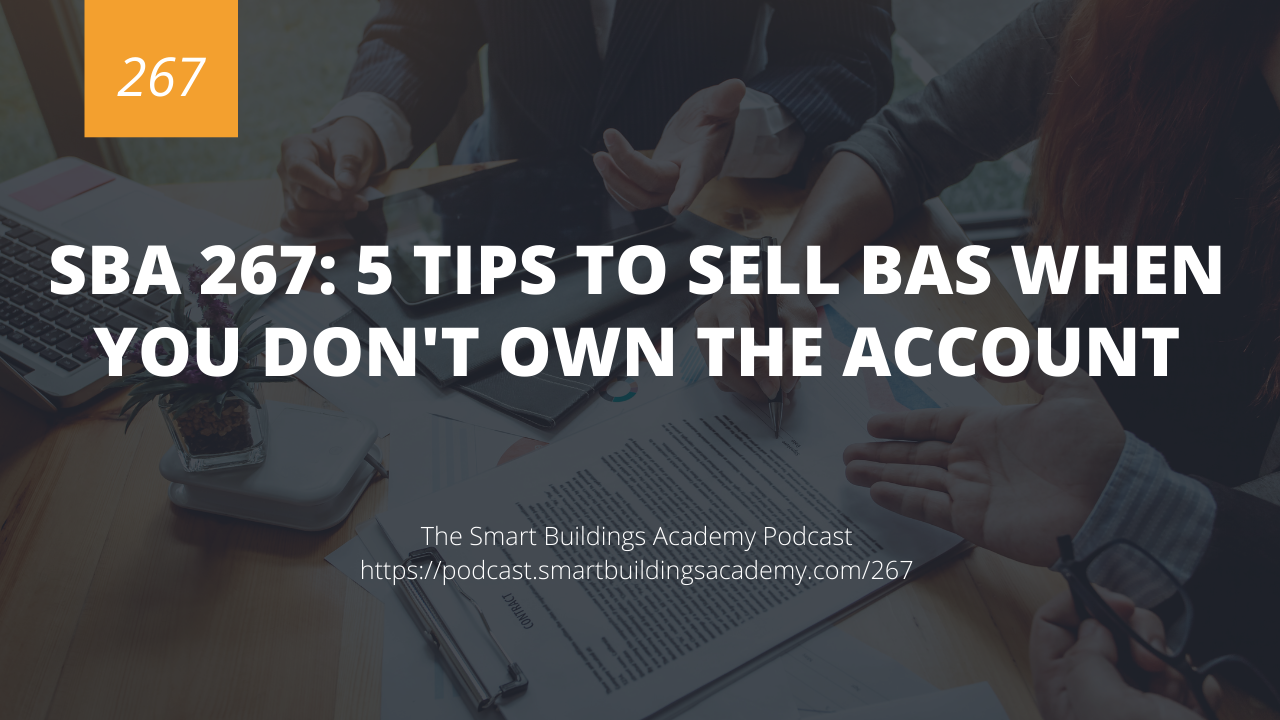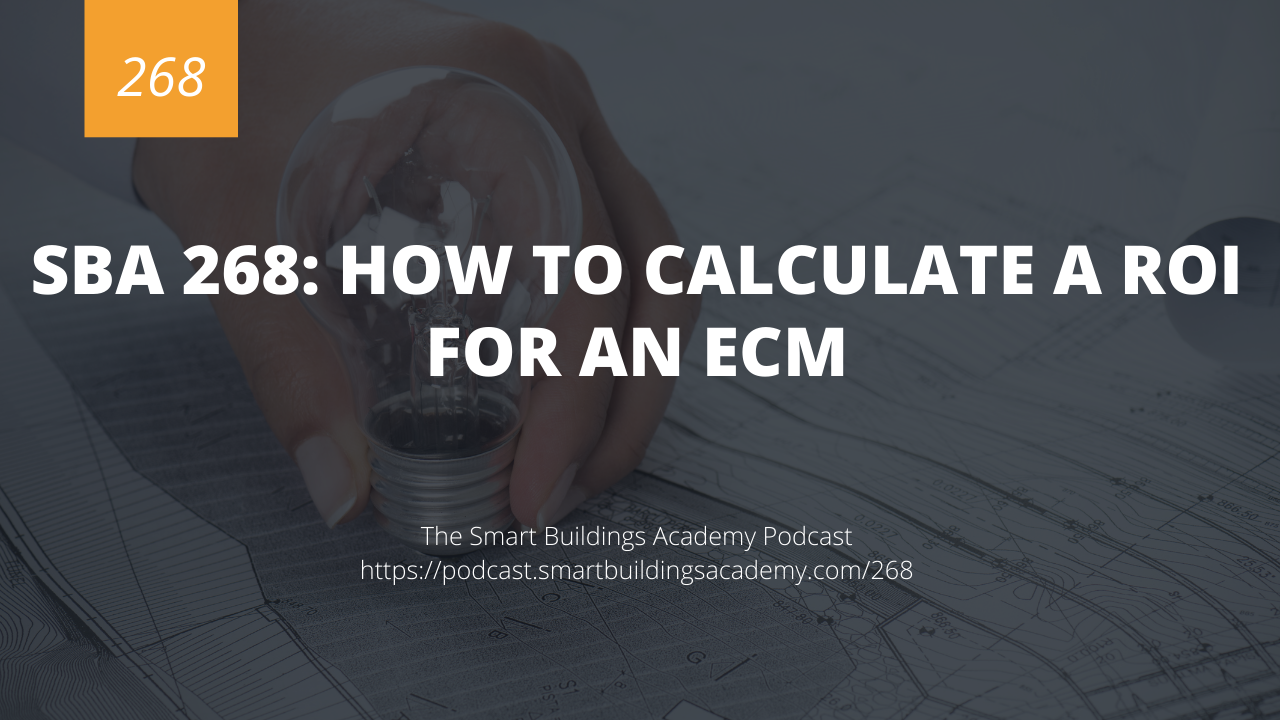In this episode we will be discussing 5 tips to sell building automation solutions to your competitors customers.
I believe we are entering a period of time where the ability to sell into existing competitors accounts will be crucial for business survival.
Click here to download or listen to this episode now.
Resources mentioned in this episode


Transcript
Phil Zito 0:00
This is the smart buildings Academy podcast with Phil Zito Episode 267. Hey folks, Phil Zito here and welcome to Episode 267 of the smart buildings Academy podcast. In this episode, we're going to be talking about the five tips to sell building automation systems. When you don't own the account, this is going to be very pertinent for a lot of you. Because a lot of you are going to be selling retrofit work construction work is starting to close up summer work starting to close up. So how are you going to make your numbers? How are you going to fill that pipeline? And how are you going to close the amount of business you need in order to make sure that you still have a job next year? Well, the trick to that is to go and sell to people who don't currently use you. Now, yes, in an ideal world, you are going to have covered all of your accounts, all of your existing accounts, you're going to have service contracts on any new construction work, you're going to be regularly on at least a quarterly basis touching base with your service customers and touching base with the technicians who service them so that you are going and creating new business with existing customers. That being said, that is not what always happens. So how can we manage to sell bs to people that currently are using someone else? This episode is sponsored by our sales bootcamp. If you are looking for answers to questions like this, and much, much more. How do you sell and retrofit scenarios? How do you sell solution sales? How do you scope an estimate? How do you go and walk jobs for retrofit work? And a lot more than I encourage you to check out our sales bootcamp at podcast at smart buildings academy.com Ford slash 267. So what are the five tips to sell VA s when you don't own the account? Well, tip number one is to be connected with your vertical market. I will tell you, in my experience, one of the greatest ways to connect with and sell into an existing competitors account is to be connected with that vertical market. You know, if you're trying to sell into health care, then be attending Ashi understand what health care operation folks are struggling with? What are the unique struggles they face? What are the unique challenges they face, and then start to connect with them start to solve their problems. Ideally, you solve the problems for this vertical market at your current customers. And then you should use the power of referrals, you should go to that existing customer and say Hey, remember when you're having trouble maintaining the temperature and humidity and the Oh ours and we solved it. Remember that time when you're having trouble doing logging for joint commission and we solved it? Well, do you know anyone else who may have those same problems that you can connect me with. And that is when you get a connection. And ideally, you are going to use that connection to get on the bid list for new construction work. It's much harder to go and sell directly a retrofit to an existing competitors customer. Now that's not to say that it can't be done. It's just more difficult. If I'm counting, you know where I'm going to put my effort. If I'm tracking where I'm going to put my effort, I'm going to put my effort into the area of greatest return, which for me is going to be getting referrals to get on bid lists, so that I can get access to accounts that I may not have had before. So that's tip number one. Tip number two, right is to go and cover the areas that your competitors are not necessarily covering and what this looks like. Can't see it. But I've got a piece of paper in front of my podcast mic here and I'm drawing a little dot and I'm drawing a circle around that dot and then I'm drawing a bigger circle around that dot and the small circle. That is typically where people focus, that's the metro areas and the initial suburbs. But beyond that is this little buffer zone. It's still in your territory, but it's a little bit out of the way. And I've known many sales people who have covered these often forgotten customers and made a lot of money doing it. Basically what you do is you go to this area that is it's not rural, but it's outside of the suburbs, and you cover it and ideally you'll pick a vertical typically I would pick K through 12. And I would cover the schools in this area because they're most likely not getting serviced. You know the trip charges are too much. They're probably not being maintained. And now you can go and especially if your office is favorably positioned. That's why I never suggest necessarily putting an office in the middle of a Metroplex.
Phil Zito 4:59
But If your office is favorably positioned, you can now use that to launch into these semi rural areas and start providing service. And as you capture these areas, remember, tip one focus on a vertical. So you focus on that vertical, maybe it's K through 12. And then you use the referral system. So you're going to see kind of right one, tip one is the referral. And tip two is work the edge. So as we work that edge, and we're using those referrals, these tips are kind of building upon one another three is offer additional services, so many customers are so many competitors rather, are going and they are executing construction work right now. But yet very few of them, and maybe maybe more than used to but in my opinion, still very few are going in actually addressing the service side of those customers. Oftentimes, they're just waiting to get out of warranty. So they can collect their retainer, and they can move on to the next project. And they're just hoping No one calls for a warranty call. That is your world that is your land to step in and start providing service discussions, maybe offer a free audit, say, hey, you just got this brand new system, what if I did a free audit of it to tell you kind of, hey, these are the punch list items. And hey, if the customer who are the competitor who installed this solution doesn't want to fix it, we're willing to give you an entry level rate to come and fix it and get your system up to snuff because you invested in it. Let's get it where it needs to be. You may laugh and you may be like, seriously, someone's really gonna spend money on fixing something during warranty phase, I can't tell you how many times I've been engaged by a customer who was a customer of one of my competitors, who at the end of warranty, so like still during warranty phase, but at the end or right after warranty expired, had my company come in and actually fix and I should be clear, smart buildings Academy does not do controls work, I met the OEM I was working with at the time, but had the company come in and actually fix the work that had been done previously. So I like to call this tip fix it up, right, so we'll fix it up. But this is focused on fixing it up new construction. Now. Okay, so you've gone, you have looked at referrals, you've looked at the edge, you fixed up new construction, and in a way you can actually pivot from edge and referral work to that fix it up new construction is you can actually go to existing customers like a school district who maybe is using multiple OEMs, multiple controls contractors, and you can then pivot from that controls contractor. Or you can pivot from your position to work on that controls contractor work to bring it kind of back up to speed. Now, tip number four is fix it up long term. So I'm going to put long term down here I'm taking my notes. And what I mean by this is this is where you start to execute retrofits. And you're starting to execute retrofits based on audits. Now, the Hot Topic audits right now are IQ, tenant engagement, and tenant retention. Okay, these are the big ones. So I IQ, you could go and provide an indoor air quality audit, you could go and log their air changes, log their temperature and humidity, show them how close or how far they are from the ASHRAE recommendations around IQ and then provide a mitigation strategy that you can implement in order to close those gaps. That would be a good entry level, low cost low effort offering that you can provide and once you've done that, then you leverage that inside knowledge basically what I would do so I would say okay, we're going to audit you, we're going to tell you where you are on this IQ guidelines. Give them a nice like two three page report, right? Once you've done that, though, then while you're doing that IQ audit, you should be gathering data, you should be gathering their logs, you should be gathering their system and you should be looking for other issues. And then you come in and you say hey, we did the IQ audit. This is how we can fix it. Oh, and by the way, we discovered this, this, this and this and we can fix it and this is the impact. Now impact is really important. We've got to talk about that. Impact means like, how is it impacting the customer on a KPI, a key performance indicator that is important to them. Not important to you but important to them what KPI is important to them? Is it their environmental air quality? Is it their ability to maintain setpoint? Is it troubleshooting calls? Is
Phil Zito 9:57
it system failures? What is their KPI find That out, and then tie that back to your recommendations. And then around tenant retention and tenant engagement, we just want to focus in on what can we do. And this actually becomes more pertinent The closer you move to the inside of city. Because you'll have more direct comparisons. Basically, it is your responsibility, especially if you serve, sell, oh my gosh can speak. If you sell into the commercial real estate market, it is your responsibility to understand what your potential customers competitors are doing from a technology and tenant engagement perspective, if they are using Wayfinding, if they are using apps, if they are using hotelling. If they're using integrated temperature and lighting control via mobile devices, you need to know this, and you need to present this to your customer. That way they know where tenants could potentially be attracted to other commercial real estate assets. And you need to go and position that. And now we come to number five, right? Number five is going to be finding the customer money. So you find out that there is a local utility that's providing energy retrofits for vfds, or you've got a local grant that's being provided, or you're able to help a school write a grant, there's a variety of ways that you can find money and bring money to a customer. And if you bring money to a customer, you could potentially do like a project development agreement. Hey, as part of this project development agreement, we are going to perform an analysis, we're going to end this ideally you would do with an existing customer first, right? So this, you're going to see how all the steps come in here, right? You're going to go to an existing customer, you're going to say, Hey, I'm going to perform an audit, I'm going to find out what's going wrong on this new build or existing belt. And I'm going to make recommendations. And then these recommendations, I'm going to help you fund I'm going to find a way to fund it, maybe it's some really nice financing that you're able to get because your company size, maybe you're able to help them write grants for or maybe you're able to help them write bond requests, all sorts of things, right. Once you've done that, though, once you've helped them identify how to get the money, then you are going to leverage that to fund the opportunity. And you're going to leverage that to create the opportunity. I hope you all have found this episode helpful. Like I mentioned in the previous episode, we're going to be spending a little bit of time, on energy on return on investment on things like that. And then we're going to be moving directly into integration. And we're going to be spending several weeks looking at systems integration. I hope you find these episodes helpful. And if you would like to learn more about how to sell building automation systems, maybe you're not making your numbers, maybe your estimates are off. Maybe you just are new to the industry and you need some strategy. Maybe you're trying to learn to sell into service and you've only sold into construction, then I really encourage you to check out our sales Bootcamp, it will be occurring in September, it's going to be nine live sessions, an hour and a half each session an hour of teaching half an hour of conversation. I have three very experienced and successful control sales persons on my team that work for me in the sales department. And they are going to be on this webinar series or this training series is live training series as well as myself. And we're going to be sharing all of our expertise with you so that you can go and have a full robust pipeline that is complete with high margin work that is delivering commission checks that make you happy, make your family happy and make your sales manager happy. So if that sounds interesting to you, I encourage you to check it out at podcasts that smart buildings Academy comm four slash 267 scroll down to the sales boot camp hyperlink, click on that and sign up. Thanks a ton and have a great rest of your day.





